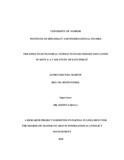| dc.description.abstract | This study assesses the effects of pastoral conflicts on secondary education with a focus on East Pokot sub-county. This therefore will assist in determining possible interventions. Importantly, the research was motivated by the need for understanding how the deteriorating performances within secondary schools are influenced by the pastoral conflicts. The study was based on three out of four secondary schools within East-Pokot sub-county whereby a total of sixty respondents were involved. Guided by this goal, the researcher set out to investigate how secondary education has been affected by the pastoral conflicts in East Pokot sub-county that has been experiencing constant violent pastoral based attacks. The study was anchored on a conceptual framework that provided the independent variable as pastoral conflict and the dependent variable as secondary education.
This study employed a case study approach where primary data was collected through interviews and filling of questionnaires while the secondary data sources were partly used to compliment the research. The data collected was structured along several thematic strands as guided by the objectives and presented along selected, graphs, tables, map and pie charts. The study found out that there was a relationship between the pastoral conflicts and secondary education as the outcomes of the latter indicated that the conflicts had effects on the students and their families. The secondary schools within the conflict prone region registered low enrolment and completion of school as most students dropped out of school along the way.
The study established that the nature of conflicts in East Pokot region was influenced by factors such as poverty, cultural practices, nomadic lifestyle and water challenges. The effects of these pastoral conflicts were on the livelihoods of the residents and consequential outcomes on school enrolment and attendance, academic performance and slowed economic development. The predominant incidents of cattle raids in the region heightened insecurity that led to destruction of property and instilled fear among the residents which consequently kept the students and teachers out of school. As a result of these effects of pastoral conflicts on secondary education, this study provides a number of intervention mechanisms that will ultimately help improve secondary education in East Pokot. They include equitable distribution of resources, initiation of a comprehensive disarmament program, increased security, inclusivity of all stakeholders in the peace-building process, and the creation of policies and strategies to improve secondary education. | en_US |



